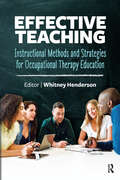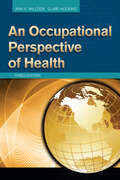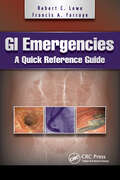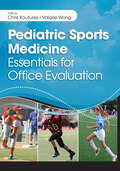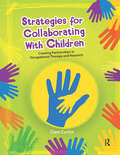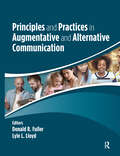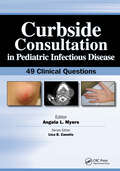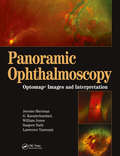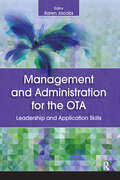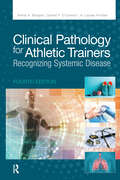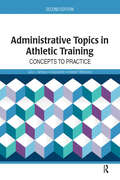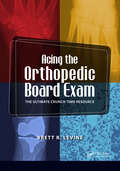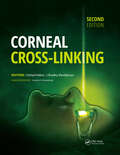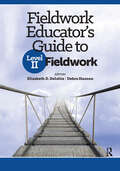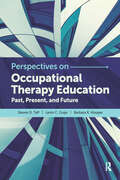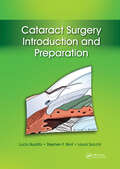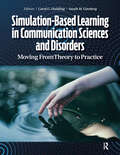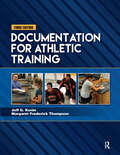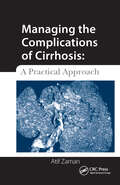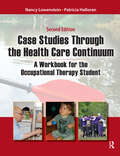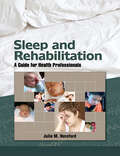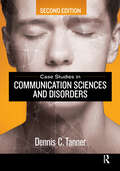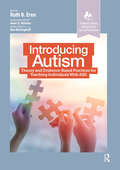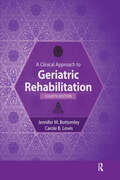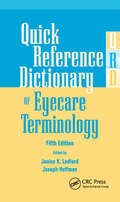- Table View
- List View
Effective Teaching: Instructional Methods and Strategies for Occupational Therapy Education
by Whitney HendersonGrounded in research and experience, Effective Teaching: Instructional Methods and Strategies for Occupational Therapy Education offers practical examples of various types of instructional methods and theoretical models for educators in occupational therapy and other allied health professions to use in evidence-based teaching. Dr. Whitney Henderson includes the latest trends and methods used in education to facilitate student-centered learning. With an easy-to-understand overview of each technique presented, allied health educators can follow step-by-step details to implement various evidence-based instructional methods. Each chapter of Effective Teaching contains: Description of the instructional method Evidence supporting use of the method Discussion of a learning theory and how the method relates to this theory Discussion of how to use the method to develop clinical reasoning Advantages and disadvantages of the method Examples of classroom use Application of the method to a professional situation With excellent explanations of theoretical foundations, ‘how-to’ methods and models, and strategies for educators to employ, Effective Teaching: Instructional Methods and Strategies for Occupational Therapy Education is a one-stop shop for implementing unique and useful instructional methods in educational courses.
An Occupational Perspective of Health
by Clare Hocking Ann WilcockFor nearly 20 years, An Occupational Perspective of Health has been a valuable text for health practitioners with an interest in the impact of what people do throughout their lives. Now available in an updated and much-anticipated Third Edition, this unique text continues the intention of the original publication: it encourages wide-ranging recognition of occupation as a major contributor to all people’s experience of health or illness. It also promotes understanding of how, throughout the world, “population health” as well as individual well-being is dependent on occupation. At international and national levels, the role of occupation in terms of the physical, mental, and social health of all individuals and populations remains poorly understood and largely overlooked as an inevitable and constant factor. An Occupational Perspective of Health, Third Edition by Drs. Ann Wilcock and Clare Hocking, in line with directives from the World Health Organization (WHO), encourages practitioners of public health, occupational therapy and others to extend current thinking and practice and embrace a holistic view of how occupation and health interact.Addressed in the Third Edition: An explanation of how individual and population health throughout the world is impacted by all that people do A drawing together of WHO ideas that relate to health through occupation, and how people individually and collectively feel about, relate to others, and grow or diminish through what they do A multidisciplinary orientation to promote health and reduce illness by increasing awareness and understanding of the impact of occupations across sleep-wake continuums throughout lifespans and communities The connection of health and occupation is held to be fundamental, although ideas about both have altered throughout time as environments and cultures have evolved. To improve interdisciplinary understanding, An Occupational Perspective of Health, Third Edition explains the concepts of attaining, maintaining, or reclaiming population health through occupation. Instructors in educational settings can visit www.efacultylounge.com for additional materials to be used for teaching in the classroom. Practitioners and students of occupational therapy, health sciences, and public or population health will benefit from and relate to An Occupational Perspective of Health, Third Edition.
GI Emergencies: A Quick Reference Guide
by Robert Lowe Francis A. FarrayeGI Emergencies: A Quick Reference Guide contains practical information regarding the diagnosis and management of common gastrointestinal emergencies. Each chapter is written by a fellow or resident with an experienced clinician. This offers the perspective of a trainee, who has many basic questions about how to handle a given situation, combined with the experience of a seasoned practitioner who can guide the work-up and treatment of each clinical case. The result is a reference that provides the clinical acumen of a trained gastroenterologist in an easy-to-use format for physicians to approach GI emergencies efficiently and thoroughly. The dual-perspectives blend perfectly together to create a practical, evidence-based read for the learning physician.In GI Emergencies: A Quick Reference Guide, Dr. Robert C. Lowe and Dr. Francis A. Farraye, along with 20 contributors, help physicians deal with problems as they occur in a “real-time” format. Some Topics Include: • Evaluation and management of acute liver failure• Caustic ingestions, foreign bodies, and food impaction• Nonvariceal upper GI hemorrhage• Acute pancreatitis• Complications of endoscopyThe case-based format is less formal than that of a typical textbook, making it enjoyable without losing the educational value and evidence-based recommendations needed to provide excellent patient care. With succinct key teaching points, GI Emergencies: A Quick Reference Guide assists physicians who are training interns, residents, and medical students in training, making it an all-around reference for those in the gastroenterology field.
Pediatric Sports Medicine: Essentials for Office Evaluation
by Chris Koutures Valarie WongPediatric Sports Medicine: Essentials for Office Evaluation is a clinically relevant reference presented in a question-and-answer format designed to be a primary resource for all pediatric providers and health care professionals who work closely with children or young adults with sports related injuries.Dr. Chris Koutures and Dr. Valarie Wong explore the topics most commonly asked pertaining to pediatric sports medicine, in a casual, yet informative manner. The unique format of this cutting-edge book provides a rapid reference and “quick look-up” for today’s busy practitioner.Pediatric Sports Medicine: Essentials for Office Evaluation includes unique chapters such as key sports medical terms and phrases, how to take a sports medicine history, what imaging studies to order, and how to determine safe return to play for many medical and musculoskeletal concerns.Additional features include:• Information on pediatric sports medicine rehabilitation• Tips on specialty referral• Generous use of tables and figures • Pictures of labeled images and radiographs that highlight key landmarks and points of emphasisWith contributions from many of the experts in the field, Pediatric Sports Medicine: Essentials for Office Evaluation is an easy-to-read resource for any medical practitioner, including physicians, nurse practitioners, physician assistants, residents, medical students, physical therapists, and athletic trainers, and many more, seeking to quickly expand their knowledge of pediatric sports medicine.
Strategies for Collaborating With Children: Creating Partnerships in Occupational Therapy and Research
by Clare CurtinStrategies for Collaborating With Children: Creating Partnerships in Occupational Therapy and Research applies client-centered and strengths-based theories to pediatric practice. The text is organized using a research-based conceptual model of collaboration. Within this text, there are detailed descriptions of how to engage and work with children aged 3 to 12 years, from the beginning to the end of therapy.Dr. Clare Curtin covers a variety of topics, such as how to interview children, involve them in defining the purpose of therapy, and develop self-advocacy. Similarly presented is the therapist’s role as a guide in setting respectful limits, teaching self-regulation, avoiding power struggles, and co-creating educational experiences that are challenging and fun. Strategies for Collaborating With Children: Creating Partnerships in Occupational Therapy and Research advocates for children's rights and participation in therapy and research. The United Nations Convention on the Rights of the Child, the new sociology of childhood, and childhood studies are discussed. Also included are children's perspectives on what therapists should know and what children said they might be thinking at each stage of therapy. The last chapter focuses on methods to enhance children’s participation in research, including adaptations for children with disabilities.Unique features: Describes a new research-based model of collaboration with children Incorporates children’s views and knowledge about therapy Illustrates the use of client-centered and strengths-based theories as well as child-friendly approaches within pediatric practice Provides over 1,600 practical strategies that are exemplified by stories with actual dialogue Describes ways to involve children throughout the research process Identifies verbal, visual, and activity-based participatory research methods for eliciting children's voices, including creative ways to involve children with different levels of abilities Includes review questions at the end of each chapter Included with the text are online supplemental materials for faculty use in the classroom.Strategies for Collaborating With Children: Creating Partnerships in Occupational Therapy and Research delivers a comprehensive resource for collaborating with children for the occupational therapist, occupational therapy assistant, or any other practitioner working with children in a therapeutic setting.
Principles and Practices in Augmentative and Alternative Communication
by Donald Fuller Lyle LloydA definitive textbook for students in speech-language pathology, audiology, and communication sciences and disorders, Principles and Practices in Augmentative and Alternative Communication offers students an introduction to augmentative and alternative communication (AAC) and prepares them for working with clients with complex communication needs.Editors Drs. Donald R. Fuller and Lyle L. Lloyd and their contributors provide a foundation for the development of assessment and intervention procedures and practices within the framework of the communication model and its major components: the means to represent, the means to select, and the means to transmit.Principles and Practices in Augmentative and Alternative Communication consists of five major units: An introduction to AAC, from its history to current practice An overview of AAC symbols and a comprehensive discussion of aided and unaided symbols A review of AAC technology The components of AAC assessment: principles, vocabulary, symbol selection, and the prescription of AAC technology AAC intervention: everything from the components of the intervention process to examples from specific cases and settings Included with the text are online supplemental materials for faculty use in the classroom.Students and professionals looking for a foundational textbook in the field of AAC will find Principles and Practices in Augmentative and Alternative Communication to be effective, contemporary, and practical.
Curbside Consultation in Pediatric Infectious Disease: 49 Clinical Questions (Curbside Consultation in Pediatrics)
by Angela MyersAre you looking for concise, practical answers to those questions that are often left unanswered by traditional pediatric infectious disease references? Are you seeking brief, evidence-based advice for complicated cases or controversial decisions? Curbside Consultation in Pediatric Infectious Disease: 49 Clinical Questions provides quick answers to the tricky questions most commonly posed during a “curbside consultation” between pediatricians. Dr. Angela L. Myers has designed this unique reference which offers expert advice, preferences, and opinions on tough clinical questions commonly associated with pediatric infectious disease. The unique Q&A format provides quick access to current information related to pediatric infectious disease with the simplicity of a conversation between two colleagues. Numerous images, diagrams, and references allow readers to browse large amounts of information in an expedited fashion. Curbside Consultation in Pediatric Infectious Disease: 49 Clinical Questions provides information basic enough for residents while also incorporating expert advice that even high-volume pediatricians will appreciate. Pediatricians, nurse practitioners, physician assistants, and family practitioners will benefit from the user-friendly, casual format and the expert advice contained within. Some of the questions that are answered: • When is imaging, such as VCUG and renal US, necessary for children with a first UTI? • Are bleach baths or chlorhexidine plus mupirocin ointment useful to decolonize patients with recurrent MRSA infections? What topical recommendations are useful for patients with recurrent MRSA infections?• What is the recommended specific treatment of otitis media due to multi-drug resistant pneumococcus? • If I have a 5-week-old infant with positive rapid viral testing, who does not need hospital admission, is a sepsis evaluation necessary? • What is likely to be the most common viral pathogens causing diarrhea, since the decrease in rotavirus cases with increase in vaccine uptake?• When are tick borne infections typically seen in the US; and when does the peak time occur?Curbside Consultation in Pediatric Infectious Disease: 49 Clinical Questions will help pediatricians to manage complex diseases and guide physicians through the maze of treatments available.Ideal for practicing pediatricians and nurse practitioners, Curbside Consultation in Pediatric Infectious Disease: 49 Clinical Questions is sure to benefit anyone caring for patients with pediatric diseases.
Panoramic Ophthalmoscopy: Optomap Images and Interpretation
by William Jones Jerry Sherman Gulshan Karamchandani Sanjeev NathPanoramic Ophthalmoscopy: Optomap® Images and Interpretation comprehensively covers the state-of-the-art technology and the high-resolution digital images taken with the Panoramic200 Scanning Laser Ophthalmoscope. The optomap® Retinal Exam images provide ophthalmologists and optometrists with an extended view and photo-documentation of almost the entire retina. Inside Panoramic Ophthalmoscopy, Jerome Sherman, Gulshan Karamchandani, William Jones, Sanjeev Nath, and Lawrence A. Yannuzzi document and expertly explain all there is to know about this remarkable new technology. Over 500 images highlight the text, many of which have never been seen before, and provide detailed visual references for numerous eye disorders. This colorful atlas is the ideal resource for interpreting these images and diagnosing serious eye conditions that may have otherwise gone undetected.Panoramic Ophthalmoscopy contains an introductory chapter that highlights and contrasts panoramic ophthalmoscopy and optomap® images to all the traditional methods of fundus viewing. Inside you will find over 100 exemplary case presentations covering common and uncommon topics such as normal fundus, retinal tears, Coat’s disease, and diabetic retinopathy. Also included are cases of retinal and choroidal diseases and how they were diagnosed and managed using this technology. In the last chapter, the authors peer into the next frontier of imaging by introducing Optos fluorescein angiography and its myriad potential contributions to patient care, research, and clinical teaching.Each case presentation includes: History and chief compliant Clinical findings optomap® images Differential diagnosis Disposition and follow-up Cases are arranged into 11 chapters covering: Optic Disc Macula Vascular Inflammatory Mass Lesions Retinal Degenerations Peripheral Lesions With expert descriptions and hundreds of never before seen images, the all encompassing Panoramic Ophthalmoscopy: Optomap® Images and Interpretation is the perfect resource for optometrists, ophthalmologists, ophthalmic technicians, residents, and students who would like to learn more about and would like to benefit from this revolutionary technology.
Management and Administration for the OTA: Leadership and Application Skills
by Karen JacobsComprehensive skills in management, administration, and leadership are essential for occupational therapy assistants (OTA) in their daily interactions with their clients in various health care environments.Inside Management and Administration for the OTA: Leadership and Application Skills, Dr. Karen Jacobs has gathered an expert team of 11 contributors of clinicians, academicians, administrators, managers, and graduate students to address each of the ACOTE Standards with a focus on evidence-based literature and examples of the leadership and management skills needed as an OTA.What you will learn from Management and Administration for the OTA: Contexts and Health Care—the potential impact of policy issues as they relate to the practice of occupational therapy Leadership and Advocacy—two important roles that OTAs need to assume to be agents of change Credentialing—introduces the national requirements for credentialing and for licensure, certification or registration under state laws Reimbursement—the various reimbursement systems requirements that affect the practice of occupational therapy Marketing and Promoting—The role of the OTA to promote the distinct value of occupational therapy to the public, as well as other professionals, service providers, consumers, third-party payers, and regulatory bodies Documentation and Quality Improvement—to ensure the OTA provides the highest quality of occupational therapy services Supervision—to understand the important relationship between the OTA, the OT, and nonprofessional personnel Fieldwork—to understand the role, criteria, and components of the OTA in fieldwork education Communication Skills—define health literacy and discuss how to use this concept to better understand the client, the client’s health environment, and the client’s occupations and health activities Ethics—explore the components of ethics that impact the delivery of occupational therapy and the foundational skills and knowledge needed by the OTA to maintain high standards of responsible, ethical practice Scholarship and Scholarly Practice—assists the OTA with how to articulate the importance of how scholarly activities and the evidence-based literature contribute to the distinct value and advancement of occupational therapy The chapters of Management and Administration for the OTA: Leadership and Application Skills also includes 5 key vocabulary terms and their definitions, case examples relevant to the content, website resources, and multiple choice review questions. Included with the text are online supplemental materials for faculty use in the classroom.Straightforward, comprehensive, and user-friendly, Management and Administration for the OTA: Leadership and Application Skills will provide OTA students and clinicians with an essential resource for their future success.
Clinical Pathology for Athletic Trainers: Recognizing Systemic Disease
by Daniel O'Connor Rehal Bhojani A. Louise FincherNewly updated with the latest professional content standards, Clinical Pathology for Athletic Trainers: Recognizing Systemic Disease, Fourth Edition provides insight on medical conditions frequently encountered in athletic training. Consistent with the profession’s shift toward the medical model, this Fourth Edition is complemented by the addition of a sports medicine physician’s perspective. Drs. Rehal A. Bhojani, Daniel P. O’Connor, and A. Louise Fincher have written this new edition to emphasize practical knowledge, clinical skills, and decision-making skills. Incorporating up-to-date standards from the Commission on Accreditation of Athletic Training Education, National Athletic Trainers’ Association position statements, and the latest guidelines for medical conditions of various organ systems, this text reflects the continued growth and evolution of the athletic trainer’s role as a health care professional. It provides comprehensive knowledge that can be adapted to clinical practices, urgent cares, academics, research, and more.The Fourth Edition includes updated: Cases Evidence and references Position statements NATA and professional documents Information on assessment, evaluation, and treatment Included with purchase is a supplemental website. Perfect for athletic trainers, athletic training students, and other health care professionals working with physically active populations throughout the lifespan, Clinical Pathology for Athletic Trainers: Recognizing Systemic Disease, Fourth Edition is a must-have for any practitioner seeking to develop their clinical skills.
Administrative Topics in Athletic Training: Concepts to Practice
by Andrew P. Winterstein Gary Harrelson Greg GardnerAdministrative Topics in Athletic Training: Concepts to Practice, Second Edition continues to be a dynamic text that addresses important administrative issues, practices, and procedures, as well as fundamental concepts, strategies, and techniques related to the management of all aspects of an athletic training health care delivery system. Uniquely, this text balances theory and application around management, administration, and leadership for the athletic trainer in multiple practice settings.Inside the Second Edition, Drs. Gary Harrelson, Greg Gardner, and Andrew Winterstein feature case studies and instructional activities, both within the text and instructor materials, to help athletic training students and clinicians understand and apply the concepts to “real world” scenarios. Numerous graphic elements such as boxes, callouts, tables, and illustrations are included throughout the text to enhance readability.New and updated features to the Second Edition: Numerous case studies, examples, and classroom activities 12 appendices provide tools and examples to aid in the application of concepts and principles addressed in the text Each chapter uses an Advanced Organizer to aid the reader in chapter orientation All chapters have been updated to include changes in laws, regulations and practices Issues in educational and clinical settings are broken into different chapters Chapters have been grouped into three sections to improve flow of the text— Personal Practices, Athletic Training Practices and Organizational Practices Faculty will have access to an Instructor’s Manual, PowerPoint slides, and Test Bank Questions Updated topics inside the Second Edition: Use of social media Multiple generations in the workplace Time management and prioritization Process of writing a business plan Athletic training as a business Starting your own business Administrative models in educational settings Impact of degree transition in athletic training Guidelines for appropriate medical coverage in secondary school and university settings Expanding roles of Athletic Trainers in clinical settings Included with the text are online supplemental materials for faculty use in the classroom.Administrative Topics in Athletic Training: Concepts to Practice, Second Edition provides beneficial information on administrative topics and will be a useful resource for athletic training students, practitioners, and any administrator responsible for supervision of athletic trainers and athletic training service programs.
Acing the Orthopedic Board Exam: The Ultimate Crunch Time Resource
by Brett LevineIn today’s fast-paced world, orthopedic residents and fellows struggle to find the time to study for the board exams, prepare for the recertification exam, prepare for the Orthopedic In-Training Examination, prepare for teaching rounds, or just plain read. What is the best way to effectively prepare and study, if reading multiple resources can’t seem to fit into your daily schedule? The answer to your study questions (and study time!) can be found inside, Acing the Orthopedic Board Exam: The Ultimate Crunch-Time Resource Until now, there has been no single high-yield volume that summarizes the “tough stuff” on the orthopedic board and recertification exams. Acing the Orthopedic Board Exam: The Ultimate Crunch-Time Resource is meant to give an edge on the really tough questions found on exams, rather than be a simple review of the basics. Why you need Acing the Orthopedic Board Exam: • Carefully vetted board-style vignettes with color images • Comprehensive yet succinct answers using a high-yield format • Emphasis on key clinical pearls and “Board Buzzwords”Acing the Orthopedic Board Exam by Dr. Brett R. Levine fills the unmet need in board review by presenting time-tested and high-yield information in a rational, useful, and contextually appropriate format.Chapters include: • A compilation of general lessons learned from past test takers • “Tough Stuff” board review vignettes • “Crunch-Time” Self-Test—Time to get Your Game On! With its focus on pearl after pearl, emphasis on images, and attention to high-yield “tough stuff” vignettes you don’t know the answers to (yet), Acing the Orthopedic Board Exam: The Ultimate Crunch-Time Resource will help you ace the orthopedic board and recertifying examinations, look good on clerkship rounds, simply challenge you with interesting and entertaining vignettes, and take optimal care of your patients in clinical practice.
Corneal Cross-Linking
by J. Bradley Randleman Farhad HafeziCorneal Cross-Linking, Second Edition represents an innovative approach to treating primary acquired and secondary induced ectatic disorders. In addition, corneal cross-linking (CXL) has promising applications as an alternative in the treatment of corneal infectious and non-infectious melting, as well as conditions such as Fuchs’ endothelial dystrophy. The new and expanded Second Edition of Corneal Cross-Linking by Drs. Farhad Hafezi and J. Bradley Randleman will provide a concise yet comprehensive summary of the CXL process, including the basic science foundations, treatment protocols and outcomes, recognition and management of potential complications, and modification of standard protocol for special circumstances. Given all the changes in this rapidly progressing field, many brief topics from the first edition have now grown into full chapters or sections. These include expanded sections on alternative treatment protocols, corneal imaging and biomechanics, combing cross-linking with other refractive treatments, and a section devoted specifically to the most highly debated controversies in the field today. With each chapter being fully updated plus including over twenty new chapters that covers the latest advances and future directions, Corneal Cross-Linking, Second Edition represents the cutting-edge of CXL research and clinical practice. “Since the publication of the first edition of this book in 2013, our knowledge of corneal cross-linking has again significantly increased, both scientifically and clinically. Today, concise recommendations (guidelines for cross-linking) help the clinician to select the patients, make decisions, and provide optimal treatment” -Eberhard Spoerl, PhD and Theo Seiler, MD, PhD
Fieldwork Educator’s Guide to Level II Fieldwork
by Debra Hanson Elizabeth DeIuliisA new, comprehensive resource for fieldwork educators and academic fieldwork coordinators, Fieldwork Educator’s Guide to Level II Fieldwork provides a blueprint for designing, implementing, and managing Level II fieldwork programs for occupational therapy and occupational therapy assistant students across practice settings.Drawing from the expertise of renowned individuals in the field, Drs. Elizabeth D. DeIuliis and Debra Hanson provide the tools for fieldwork educators and academic fieldwork coordinators to put together learning frameworks, educational theories, and clinical instructional techniques within and outside occupational therapy in order to create and maintain high-quality Level II learning experiences. Fieldwork Educator’s Guide to Level II Fieldwork challenges fieldwork educators and academic fieldwork coordinators to shift their mindset to facilitating skill acquisition and to adjust their teaching approach to match the learning needs and developmental level of the student.Designed to meet the definition of Level II fieldwork according to the 2018 Accreditation Council for Occupational Therapy Education standards, and in response to common pitfalls and challenges in clinical education today, Fieldwork Educator’s Guide to Level II Fieldwork is the go-to guide for the busy practitioner and academic fieldwork coordinator.What is included in Fieldwork Educator’s Guide to Level II Fieldwork: Expansive overviews of supervision models and vignettes illustrating use across practice settings Examples and templates to construct a learning plan, site-specific learning objectives, orientation, weekly schedules, and learning contracts Tools and strategies to uniquely develop and foster clinical reasoning in fieldwork Models for dually approaching supervision and mentorship Strategies for addressing unique student learning and supervision needs Fieldwork Educator’s Guide to Level II Fieldwork can be used as a standalone resource or as a complement to Fieldwork Educator’sGuide to Level I Fieldwork, which was designed in-tandem with this text to holistically address Levels I and II fieldwork education
Perspectives on Occupational Therapy Education: Past, Present, and Future
by Barbara Hooper Steven Taff Lenin GrajoPerspectives on Occupational Therapy Education: Past, Present, and Future outlines a path forward for occupational therapy educators, incorporating the impact of historical context, contemporary issues and trends, and international viewpoints on the development of the profession.With this mission in mind, Drs. Steven D. Taff, Lenin C. Grajo, and Barbara R. Hooper offer helpful tips, practical tools, and fresh insights to support current and future educators in developing their teaching philosophies and pedagogies. The book is divided into three main sections—past, present, and future—and examines:• The history of occupational therapy education, including the influence of critical philosophies, their relationship to higher education and healthcare, and the growth of accreditation standards and professional degree programs.• Current trends and challenges in healthcare and higher education, including bridging the gap between education and practice, the use of competency exams, expanding educational research, and promoting diversity and inclusion among faculty and students.• International perspectives on the development and future of occupational therapy education from leading scholars in Africa, Australia, Europe, North America, South America, and Southeast Asia, including trends in educational technologies, fieldwork education and requirements, and inter-professional education.An indispensable resource for educators, Perspectives on Occupational Therapy Education: Past, Present, and Future concludes with an imagining of the occupational therapy education landscape in the year 2050: a future in which occupational therapy educators are continuously responding to ongoing changes in health care policies, adapting to a more diverse and globally connected student population, and articulating the distinct value of occupational therapy in new and emerging areas of practice.Included with the text are online supplemental materials for faculty use in the classroom.
Cataract Surgery: Introduction and Preparation
by Lucio Buratto Stephen Brint Laura SacchiCataract Surgery: Introduction and Preparation offer the latest information and examines the most popular instruments used, the preoperative examination, and the operating technique for cataract surgery. Dr. Lucio Buratto, Dr. Stephen Brint, and Dr. Laura Sacchi provide a step-by-step approach to facilitate assessing the patient, performing the technique, and managing cataract surgery in the most optimal way possible. Cataract Surgery: Introduction and Preparation will lead beginning surgeons down the exciting path of cataract surgery as they increase their knowledge of phacoemulsification and the femtolaser by learning all the details associated with the procedures. Cataract Surgery: Introduction and Preparation covers a wide variety of topics, including presurgery examination, incisions, capsulorhexis, hydrodissection, prevention of endophthalmitis, and ophthalmic viscosurgical devices for modern cataract surgery. Supplemented by more than 200 color illustrations, diagrams, a glossary, and references, all surgeons from beginner to expert will want this unique resource by their side.
Simulation-Based Learning in Communication Sciences and Disorders: Moving from Theory to Practice
by Sarah Ginsberg Carol DuddingA new resource for academic and clinical educators, Simulation-Based Learning in Communication Sciences and Disorders: Moving From Theory to Practice presents best practices in simulations for undergraduate, graduate, and workplace training programs in audiology, speech-language pathology, and communication sciences and disorders.Utilizing the expertise of experienced clinical educators, Simulation-Based Learning in Communication Sciences and Disorders is an introductory to intermediate text for those interested in implementing clinical simulations within undergraduate and graduate training programs, as well as the workplace. To that end, it includes descriptions of various simulation technologies, ranging from low to high fidelity, as well as examples for implementation.The text is divided into three main sections: Foundations in Clinical Simulations provides an overview of foundational theories in simulation-based learning and principles of teaching and learning in higher education Clinical Simulation Learning Experiences expands upon the various forms of simulation technology, outlines the best practices for implementing simulations for learning, and identifies ways for educators to incorporate simulation technologies into their curriculum Professional Issues and Advocacy calls on readers to engage in professional development and research in the area of simulations; readers are encouraged to consider ways in which existing and emerging technologies can help us adapt to the upcoming changes in education and training Simulation-Based Learning in Communication Sciences and Disorders: Moving From Theory to Practice is one of the first books to integrate best practices in simulation research and practice specifically for academics and clinical educators in communication sciences and disorders. It is an invaluable guide to anyone who is interested in providing high-quality learning experiences through simulation to students and professionals in communication sciences and disorders.
Documentation for Athletic Training
by Jeff G. Konin Margaret Frederick ThompsonDocumentation for Athletic Training, Third Edition provides all the important and relevant information that a practicing athletic trainer needs to possess to provide accurate documentation. These topics include legal considerations, electronic medical records, and numerous tips for effective verbal and written communication styles. This Third Edition by Drs. Jeff G. Konin and Margaret Frederick Thompson continues to provide a plethora of standard templates to refer to as examples of the most commonly used forms in athletic training practice settings. The authors represent decades of collective experience as clinicians, educators, and administrators and offer insight on the importance of timely and appropriate methods for athletic training documentation.Documentation for Athletic Training, Third Edition has strengthened chapters on electronic documentation and documentation for reimbursement. These are continuously-evolving areas that require an understanding of not just a single type of software system, but rather a foundation of knowledge related to the principles of each. Additionally, a chapter has been added on contemporary type of documentation. Communication in the forms of text messages, social media, and other common types of information sharing are discussed. Features inside the Third Edition: Learning objectives for each chapter “Pearls of Wisdom” on key points Discussion and study questions Worksheets and commonly used documentation forms Glossary of terms Symbols and medical terminology abbreviations Documentation for Athletic Training, Third Edition continues to be the only textbook dedicated to the topic of documentation and presents a wide array of methods and forms, providing students, educators, and clinicians with a multifaceted tool box for their documentation needs.
Managing the Complications of Cirrhosis: A Practical Approach
by Atif ZamanManaging the Complications of Cirrhosis: A Practical Approach is a simple pocket guide for the community gastroenterologist and primary-care provider who manages liver disease. While there are other books available on the market regarding the management of cirrhosis, this reference includes information geared toward the busy practitioner, allowing the reader to reference a chapter that easily addresses the clinical issue at hand. Dr. Atif Zaman provides essential and current information on the management of cirrhosis for the nonhepatologist.Each chapter in Managing the Complications of Cirrhosis: A Practical Approach is broken down into four sections, including a summary of the issue at hand, a diagnosis of the problem, a treatment algorithm, and what to do if the treatment algorithm is ineffective. In addition, each chapter highlights complex cases that have no standard treatment, but have emerging concepts or data.Chapter topics include:• Preventative health issues in patients with cirrhosis• Nutrition in patients with cirrhosis• Management of hepatocellular carcinoma• Pulmonary issues in patients with cirrhosis• Timing of referral for liver transplantWith algorithms and tables, Managing the Complications of Cirrhosis: A Practical Approach is the perfect book for all community gastroenterologists, primary-care practitioners, medical residents and fellows, physician assistants, and nurse practitioners who provide care in the area of liver disease.
Case Studies Through the Health Care Continuum: A Workbook for the Occupational Therapy Student
by Nancy Lowenstein Patricia HalloranThe extensively updated Second Edition of Case Studies Through the Health Care Continuum: A Workbook for the Occupational Therapy Student is a versatile resource that focuses on assisting students through the use of case studies. Through these 34 cases, students learn about the many possible choices in the clinical decision-making process, and how these different choices can lead to many equally successful outcomes.Case Studies Through the Health Care Continuum, Second Edition by Nancy Lowenstein and Patricia Halloran encompasses new and revised case studies across the health care continuum, from early intervention to older adults. These cases involve situations that students might encounter during their interventions and require them to think about issues that might occur to disrupt their original intervention plan.Inside Case Studies Through the Health Care Continuum, Second Edition, new questions on theory and evidence will allow students to think of theory-driven and evidence-based practice concepts, as well as search the literature to support their interventions. Care was also taken to avoid using a specific frame of reference or theoretical model to enable instructors to use various frames of reference and theories with different cases.New to the Second Edition: Each case allows the student to consider the client’s occupations, performance patterns, performance skills, client factors, contexts, and environments Case studies are now formatted around an Occupational Profile and an Analysis of Occupation, adhering to the AOTA’s Occupational Therapy Practice Framework language Pediatric case studies Increased number of community case studies Case study on primary care, an emerging practice area in occupational therapy Case studies involving complex conditions, not just one condition Case Studies Through the Health Care Continuum: A Workbook for the Occupational Therapy Student, Second Edition is a valuable learning tool for any occupational therapy or occupational therapy assistant student as it provides a way to put theories and clinical reasoning into practice through the use of case studies.
Sleep and Rehabilitation: A Guide for Health Professionals
by Julie HerefordSleep and Rehabilitation: A Guide for Health Professionalsis a concise reference for the health professional looking to further understand sleep and how sleep science may impact particular areas of various rehabilitation disciplines. Dr. Julie M. Hereford and her contributors present Sleep and Rehabilitation: A Guide for Health Professionalsin an easy-to-read manner by dividing the text into four main sections. The first section provides a review of the basic scientific understanding of sleep. While there are many other publications that present a basic scientific understanding of sleep, Sleep and Rehabilitation systematically gears this information toward the rehabilitation professional with commonly used terminology, descriptions of sleep architecture, and information concerning sleep hygiene. The middle sections of Sleep and Rehabilitationdescribe disordered sleep and how it pertains to patients seen in the rehabilitation setting. It guides the health professional to recognize the manifestations and consequences of disordered sleep and teaches the rehabilitation professional how to interpret a sleep study in order to provide guidance in clinical decision making. Finally, the last section of Sleep and Rehabilitationprovides the ever-important practical application of the theoretical principles in sleep rehabilitation.Features include: Discussion on the science of polysomnography Sleep and sleep dysfunction from a rehabilitation perspective Sleep dysfunction as it relates to the clinical needs of a patient undergoing the rehabilitation process Discussion on the particular concerns that sleep and sleep dysfunction can hold for rehabilitation patients and issues to be addressed by the provider Presentation of unique issues that disordered sleep may present in the rehabilitation process such as on pain, pain management, motor learning, and memory and performance enhancement Tools to assess quality and quantity of a patient’s sleep Discussion on methods in which sleep may be manipulated in order to optimize a patient’s physical performance Sleep and Rehabilitation: A Guide for Health Professionalsis a one-of-a-kind reference that will help the health professional incorporate the science of sleep into the rehabilitation process.
Case Studies in Communication Sciences and Disorders
by Dennis TannerThe discipline of communication sciences and disorders is an exciting field that appreciates the wonders and complexities of human communication. Case Studies in Communication Sciences and Disorders, Second Edition is an informative and relevant text that addresses the myriad disorders, deficits, diseases, and disabilities that can lay waste to the incredible systems involved in communication.Case Studies in Communication Sciences and Disorders, Second Edition by Dr. Dennis Tanner provides engaging factual and historical information about each of the major communication disorders. The case studies presented in each chapter uncover the functional barriers encountered by clients of practicing speech-language pathologists and audiologists. Each chapter provides a scholarly overview of a communication disorder with an emphasis on etiology, diagnosis, and treatment and uses several case studies to illustrate the many different presentations of each disorder. Over 50 case studies reflect true clinical practice and include detailed patient histories that give humanity and depth to the patient-clinician relationship.Chapter Topics in the Second Edition Include: Language delays and disorders Articulation and phonology disorders Stuttering Voice and resonance disorders Aphasia Motor speech disorders Dysphagia Traumatic brain injury Hearing loss and deafness Case Studies in Communication Sciences and Disorders, Second Edition is a relevant and readable text for speech-language pathology and audiology students and clinicians that takes theory and clinical reasoning and applies them to a variety of interesting cases.
Introducing Autism: Theory and Evidence-Based Practices for Teaching Individuals with ASD (Evidence-Based Instruction in Special Education)
by Ruth ErenWritten by educators for educators, Introducing Autism: Theory and Evidence-Based Practices for Teaching Individuals With ASD is an introductory text offering a broad picture of Autism Spectrum Disorder for students, teachers, related service providers, and other school personnel who are engaged in the education of individuals with ASD.Introducing Autism imparts knowledge and understanding of the broad spectrum of ASD and suggests evidence-based practices to support this population. Editor Dr. Ruth Eren and the text contributors provide readers with a firm foundation of facts, strategies, and processes that help explain and address the complex profile of an individual with ASD. As a result of this understanding, current and future practitioners will be equipped with the skills and strategies to work collaboratively and effectively with their school team as they create a program for a student on the spectrum.What’s included in Introducing Autism: Content supported by case studies based in authentic educational settings Evidence-based practices suggested for use in the classroom Voices from the Spectrum sections in each chapter which feature the viewpoints from individuals on the spectrum Introducing Autism: Theory and Evidence-Based Practices for Teaching Individuals With ASD will enable universities to offer a comprehensive course that provides a strong foundation of knowledge and understanding of ASD to prepare teachers and related service providers for certification.
A Clinical Approach to Geriatric Rehabilitation
by Carole Lewis Jennifer BottomleyThe field of geriatric rehabilitation is constantly changing due to the discovery of new evidence-based evaluation and treatment strategies, as well as the continual support or refutation of older theories and practices. Now in itsFourth Edition, A Clinical Approach to Geriatric Rehabilitation has been updated to be at the forefront of these changes and includes free video content from MedBridge and a discount on a MedBridge subscription to geriatric rehabilitation courses offered by the authors.Drs. Jennifer M. Bottomley and Carole B. Lewis have compiled the plethora of available scientific research on geriatric populations and combined it with their years of actual clinical practice. Together this makes this text a complete evidence-based guide to the clinical care of geriatric patients and clients.The first part of A Clinical Approach to Geriatric Rehabilitation, Fourth Edition tackles applied gerontological concepts, providing the general knowledge base necessary for treating geriatric patients. Topics in this section include patient evaluation, an exploration of nutritional needs, and age-related changes in physiology and function, as well as many other foundational areas.In the second section, topics become more focused on patient care concepts like neurologic considerations, cardiopulmonary and cardiovascular considerations, and establishing community-based screening programs.In the final section, chapters center on administration and management, including important subjects such as attitudes, ethics, and legal topics, as well as consultation and research.New and updated in the Fourth Edition: Pearls section for succinct highlights of the content within each chapter The latest evidence-based practice interventions with complete references for further reading Updated graphics, pictures, and diagrams to illustrate the content Content summaries and streamlined text for enhanced readability Updated case studies to exemplify clinical decision-making Designed to provide valuable, real-life clinical knowledge, A Clinical Approach to Geriatric Rehabilitation, Fourth Edition gives physical therapists an evidence-based guide to the clinical aspects of rehabilitative care in older adult patients and clients.
Quick Reference Dictionary of Eyecare Terminology
by Janice K. Ledford Joseph HoffmanA leading resource for nearly two decades and a daily reference for thousands of eyecare professionals, the Fifth Edition of Quick Reference Dictionary of Eyecare Terminology continues this tradition and provides the latest terms, concepts, conditions, and important resources in an instant. Janice K. Ledford and Joseph Hoffman have updated and expanded this essential resource to reflect today’s dialect while retaining the core features associated with this user-friendly reference book: accurately defined terms, cross-referencing, acronyms and abbreviations, and a plethora of additional information in the appendices. Compact, concise, and informative, Quick Reference Dictionary of Eyecare Terminology, Fifth Edition, provides quick access to over 3,700 terms and their definitions, including over 400 new words. This pocket-sized companion also contains 25 appendices. Additionally, pronunciations have been added—an attribute users are sure to appreciate. With a history of excellence, an easy-to-use format, and the latest information, Quick Reference Dictionary of Eyecare Terminology, Fifth Edition is a must have for anyone working in eyecare or an eyecare-related industry.Features: An atlas of ocular anatomy drawings Updated list of pertinent web sites Updated drug tables A reading guide Appendices Include: Medical terminology Subjective grading systems Common abbreviations The metric system English-to-Spanish ocular history flow sheet
